Analysis of Lean, Six Sigma, and Mass Customization in Operations
VerifiedAdded on 2021/08/10
|16
|1490
|51
Report
AI Summary
This report provides an overview of key concepts in operations and project management. It focuses on three primary areas: lean synchronization, Six Sigma, and mass customization. Lean synchronization emphasizes waste elimination, fast throughput, and meeting demand instantaneously with perfect quality. The report explains the concepts of Muda, Mura, and Muri, which are Japanese terms that identify sources of waste, along with the seven types of waste. Six Sigma, a data-driven approach, is presented as a methodology for eliminating defects. The report discusses the stages involved in reaching Six Sigma. Finally, mass customization is examined as a process that allows for product personalization while maintaining low costs. The report highlights the benefits and examples of mass customization, offering a comprehensive look at these critical operations management strategies.

Paraphrase This Document
Need a fresh take? Get an instant paraphrase of this document with our AI Paraphraser
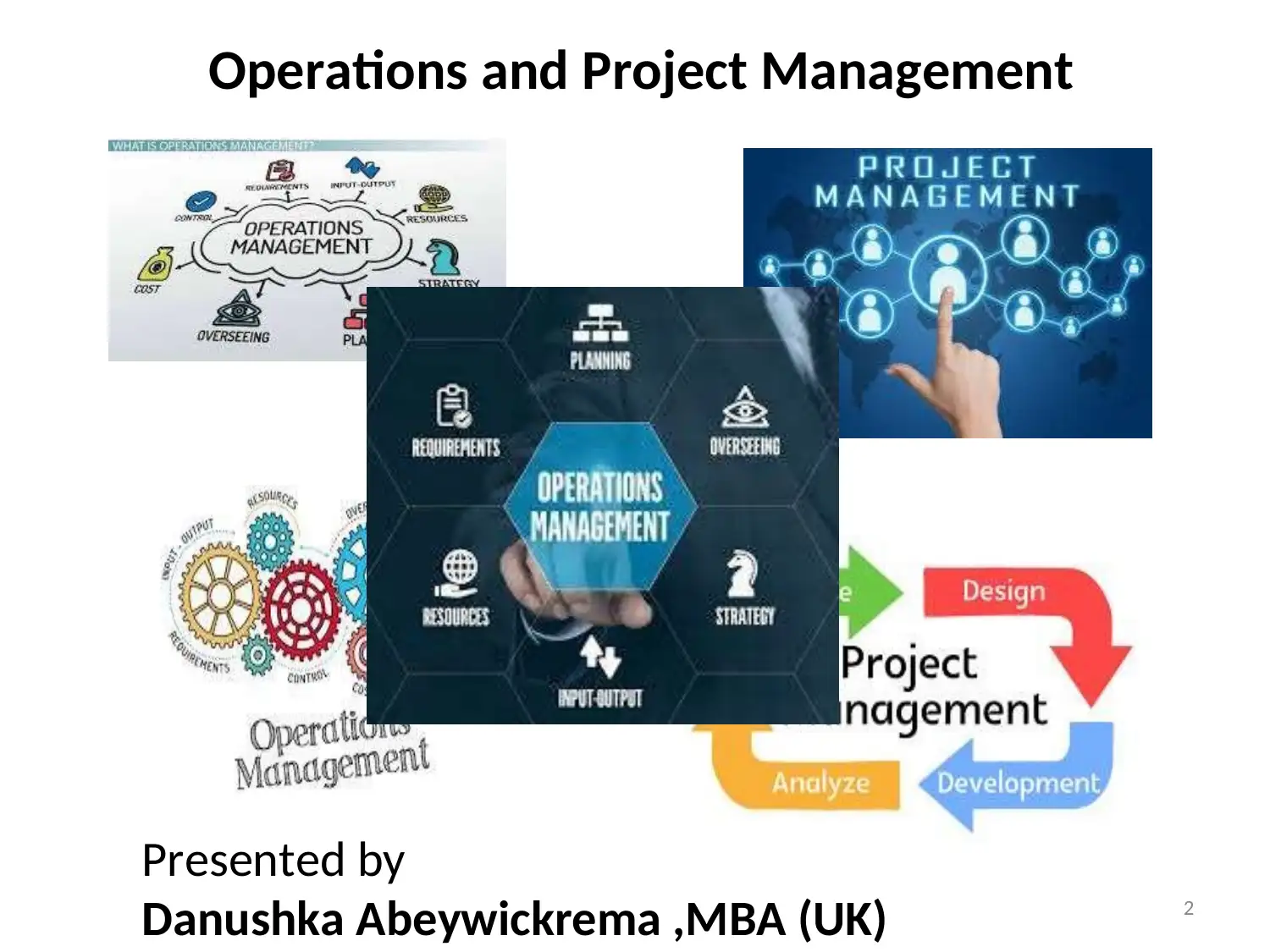
2
Operations and Project Management
Presented by
Danushka Abeywickrema ,MBA (UK)
Operations and Project Management
Presented by
Danushka Abeywickrema ,MBA (UK)
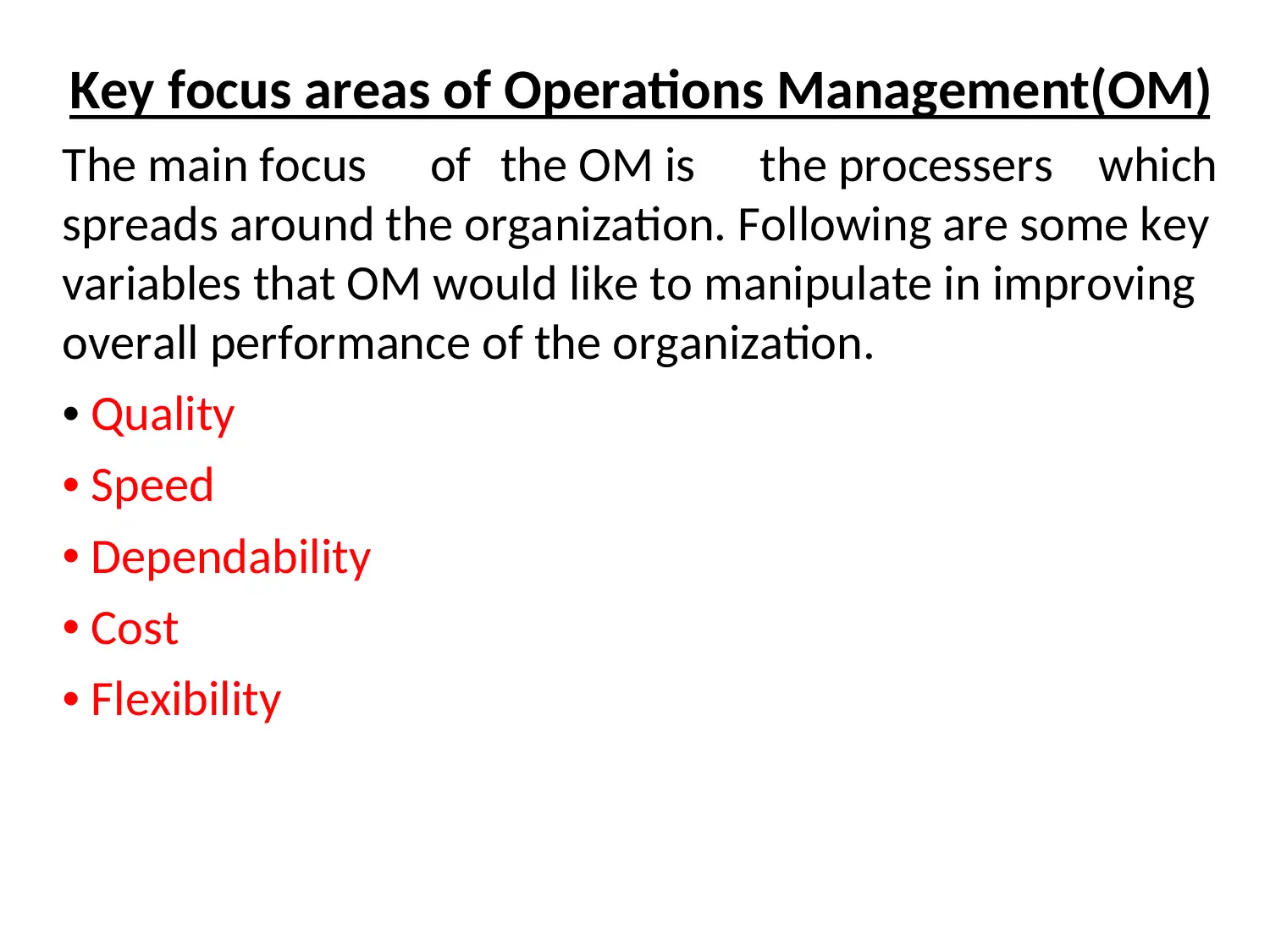
Key focus areas of Operations Management(OM)
The main focus of the OM is the processers which
spreads around the organization. Following are some key
variables that OM would like to manipulate in improving
overall performance of the organization.
• Quality
• Speed
• Dependability
• Cost
• Flexibility
The main focus of the OM is the processers which
spreads around the organization. Following are some key
variables that OM would like to manipulate in improving
overall performance of the organization.
• Quality
• Speed
• Dependability
• Cost
• Flexibility
⊘ This is a preview!⊘
Do you want full access?
Subscribe today to unlock all pages.

Trusted by 1+ million students worldwide
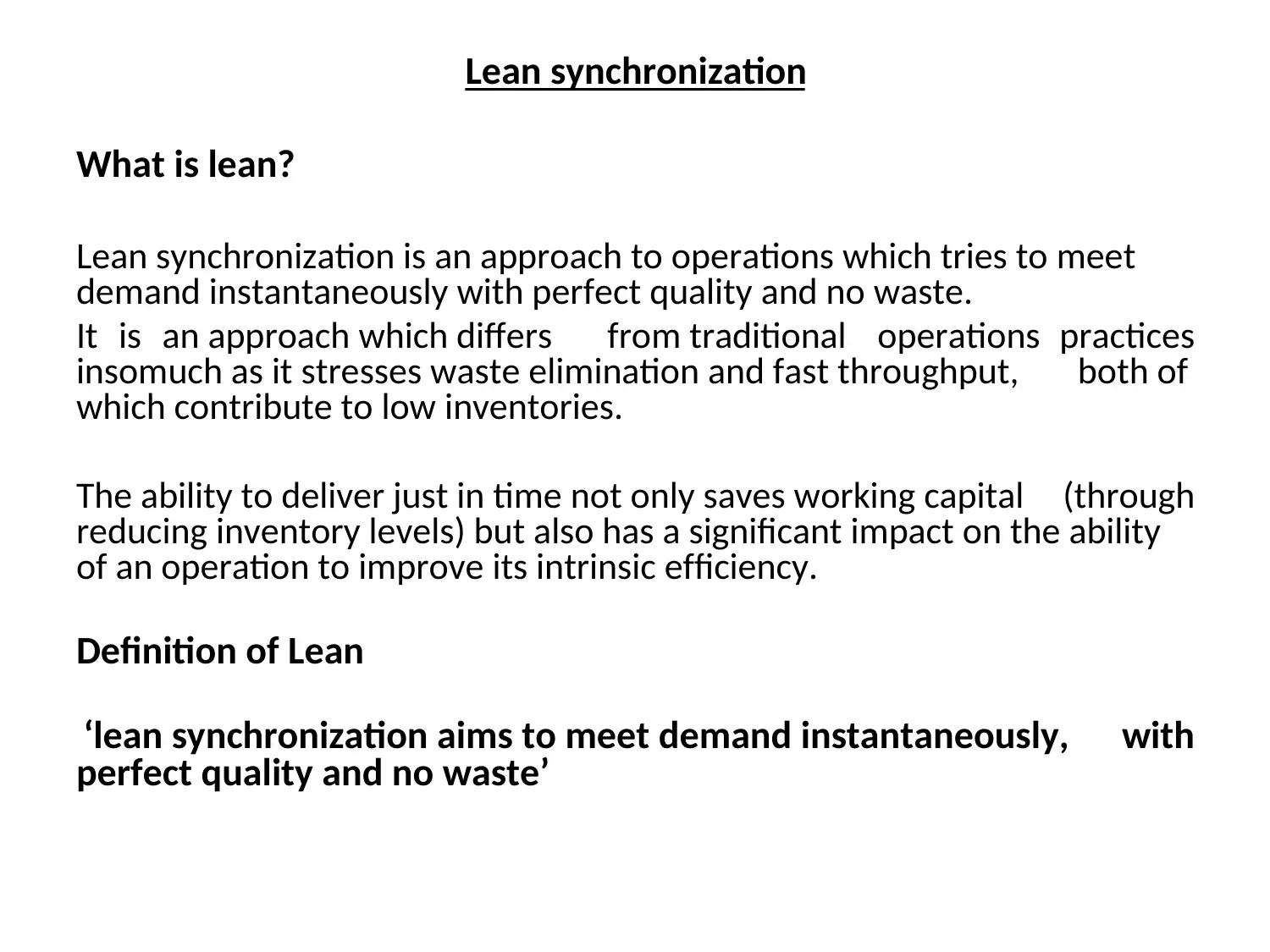
Lean synchronization
What is lean?
Lean synchronization is an approach to operations which tries to meet
demand instantaneously with perfect quality and no waste.
It is an approach which differs from traditional operations practices
insomuch as it stresses waste elimination and fast throughput, both of
which contribute to low inventories.
The ability to deliver just in time not only saves working capital (through
reducing inventory levels) but also has a significant impact on the ability
of an operation to improve its intrinsic efficiency.
Definition of Lean
‘lean synchronization aims to meet demand instantaneously, with
perfect quality and no waste’
What is lean?
Lean synchronization is an approach to operations which tries to meet
demand instantaneously with perfect quality and no waste.
It is an approach which differs from traditional operations practices
insomuch as it stresses waste elimination and fast throughput, both of
which contribute to low inventories.
The ability to deliver just in time not only saves working capital (through
reducing inventory levels) but also has a significant impact on the ability
of an operation to improve its intrinsic efficiency.
Definition of Lean
‘lean synchronization aims to meet demand instantaneously, with
perfect quality and no waste’
Paraphrase This Document
Need a fresh take? Get an instant paraphrase of this document with our AI Paraphraser
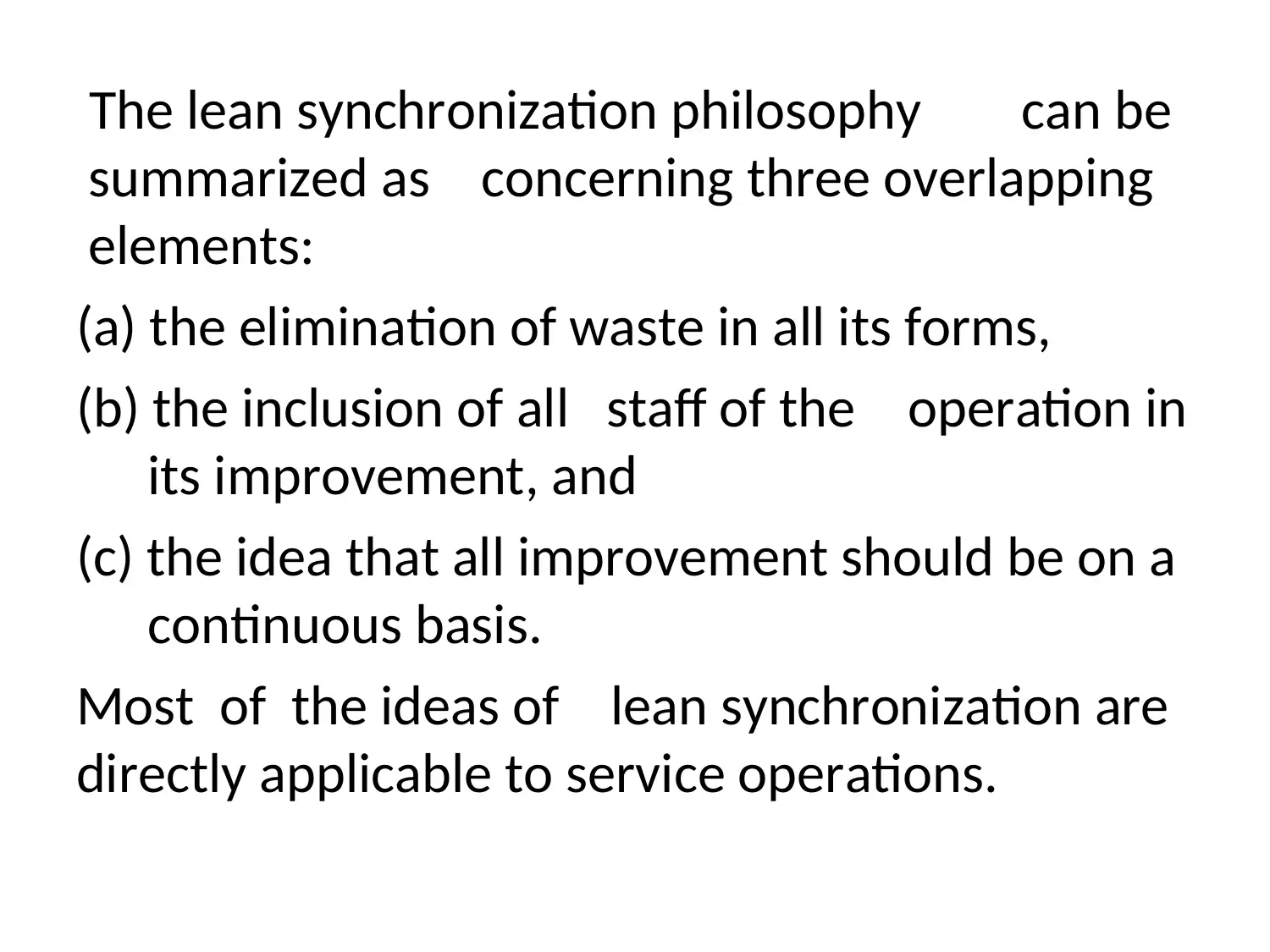
The lean synchronization philosophy can be
summarized as concerning three overlapping
elements:
(a) the elimination of waste in all its forms,
(b) the inclusion of all staff of the operation in
its improvement, and
(c) the idea that all improvement should be on a
continuous basis.
Most of the ideas of lean synchronization are
directly applicable to service operations.
summarized as concerning three overlapping
elements:
(a) the elimination of waste in all its forms,
(b) the inclusion of all staff of the operation in
its improvement, and
(c) the idea that all improvement should be on a
continuous basis.
Most of the ideas of lean synchronization are
directly applicable to service operations.
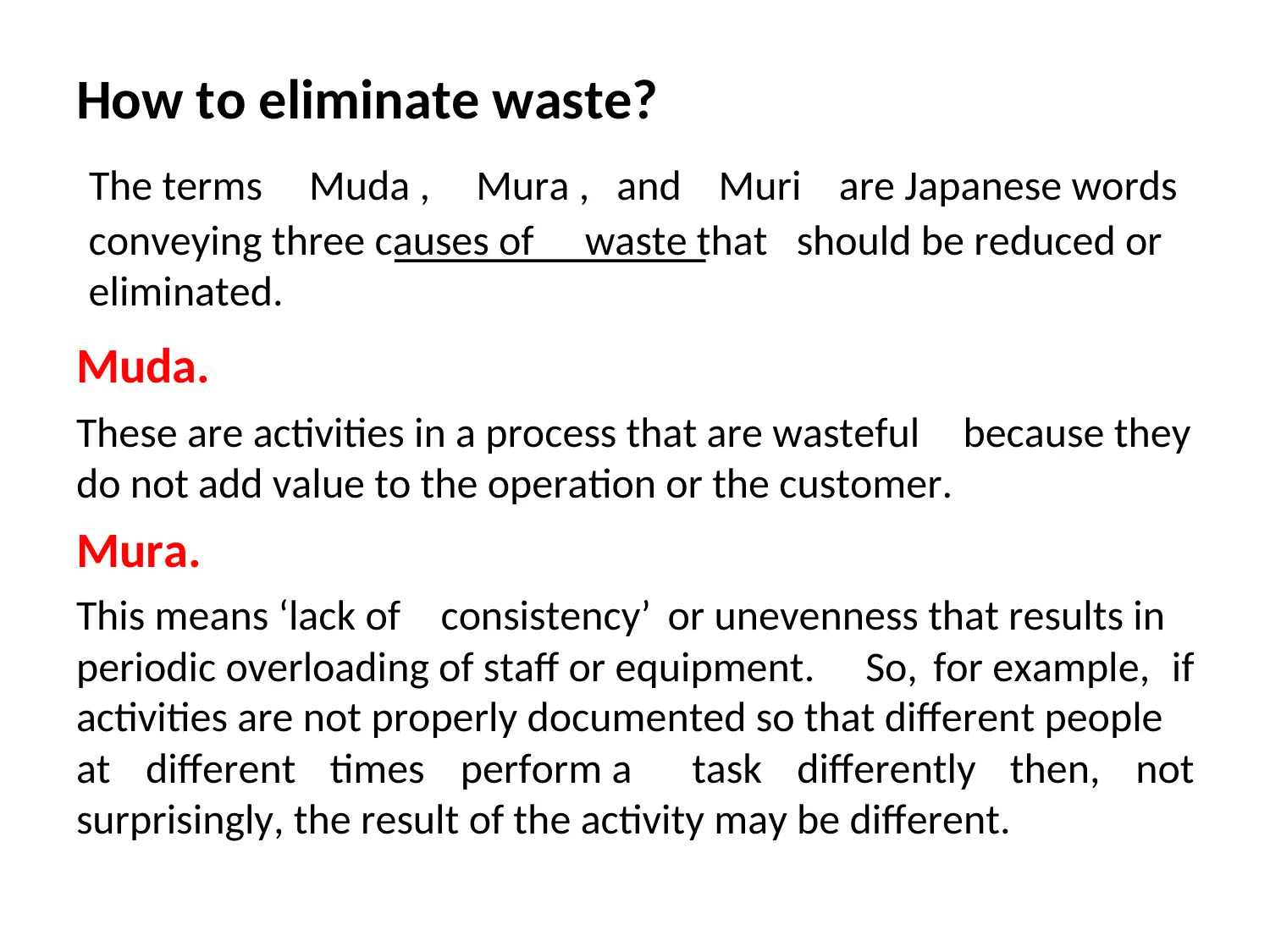
How to eliminate waste?
The terms Muda , Mura , and Muri are Japanese words
conveying three causes of waste that should be reduced or
eliminated.
Muda.
These are activities in a process that are wasteful because they
do not add value to the operation or the customer.
Mura.
This means ‘lack of consistency’ or unevenness that results in
periodic overloading of staff or equipment. So, for example, if
activities are not properly documented so that different people
at different times perform a task differently then, not
surprisingly, the result of the activity may be different.
The terms Muda , Mura , and Muri are Japanese words
conveying three causes of waste that should be reduced or
eliminated.
Muda.
These are activities in a process that are wasteful because they
do not add value to the operation or the customer.
Mura.
This means ‘lack of consistency’ or unevenness that results in
periodic overloading of staff or equipment. So, for example, if
activities are not properly documented so that different people
at different times perform a task differently then, not
surprisingly, the result of the activity may be different.
⊘ This is a preview!⊘
Do you want full access?
Subscribe today to unlock all pages.

Trusted by 1+ million students worldwide
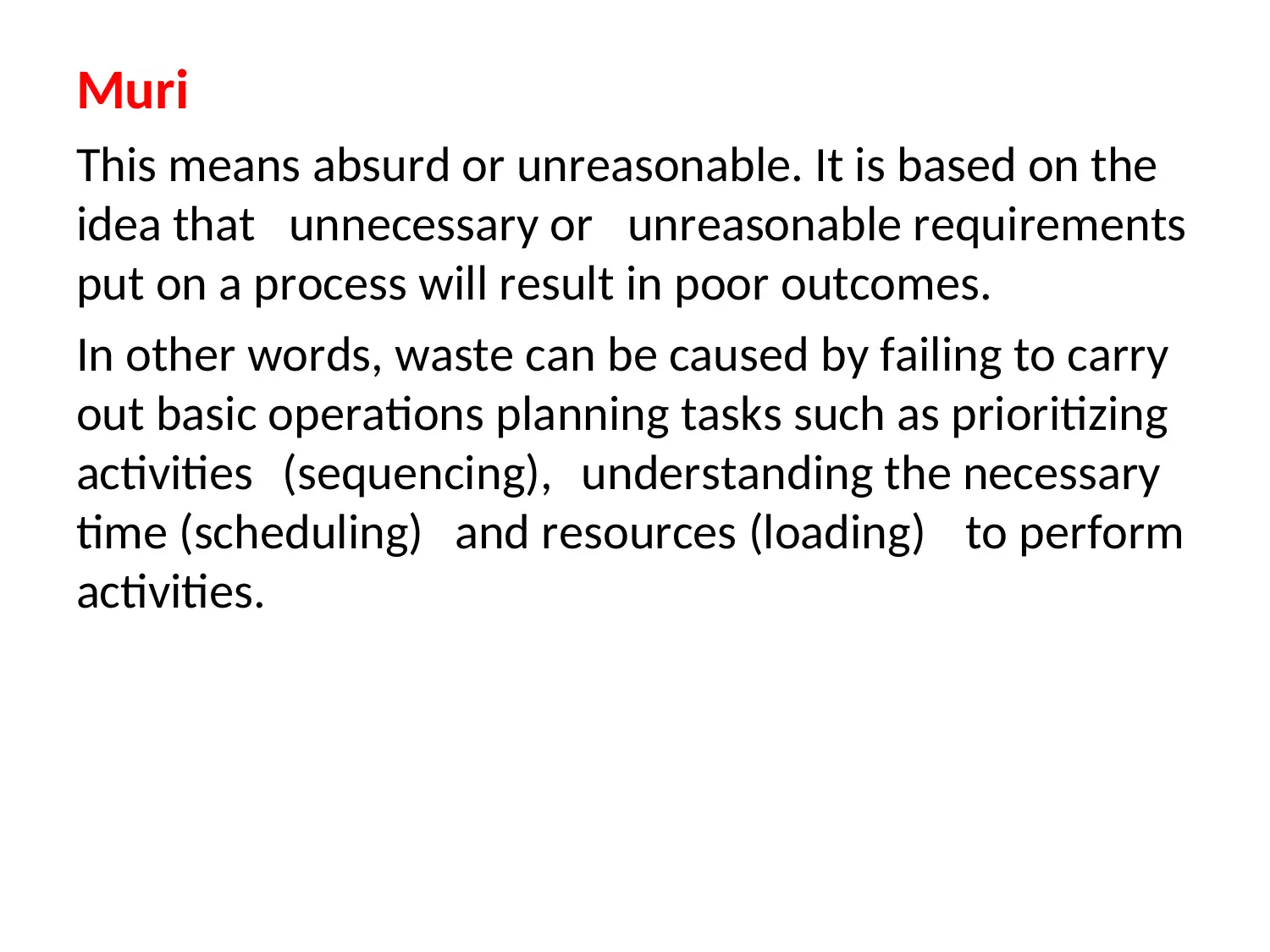
Muri
This means absurd or unreasonable. It is based on the
idea that unnecessary or unreasonable requirements
put on a process will result in poor outcomes.
In other words, waste can be caused by failing to carry
out basic operations planning tasks such as prioritizing
activities (sequencing), understanding the necessary
time (scheduling) and resources (loading) to perform
activities.
This means absurd or unreasonable. It is based on the
idea that unnecessary or unreasonable requirements
put on a process will result in poor outcomes.
In other words, waste can be caused by failing to carry
out basic operations planning tasks such as prioritizing
activities (sequencing), understanding the necessary
time (scheduling) and resources (loading) to perform
activities.
Paraphrase This Document
Need a fresh take? Get an instant paraphrase of this document with our AI Paraphraser
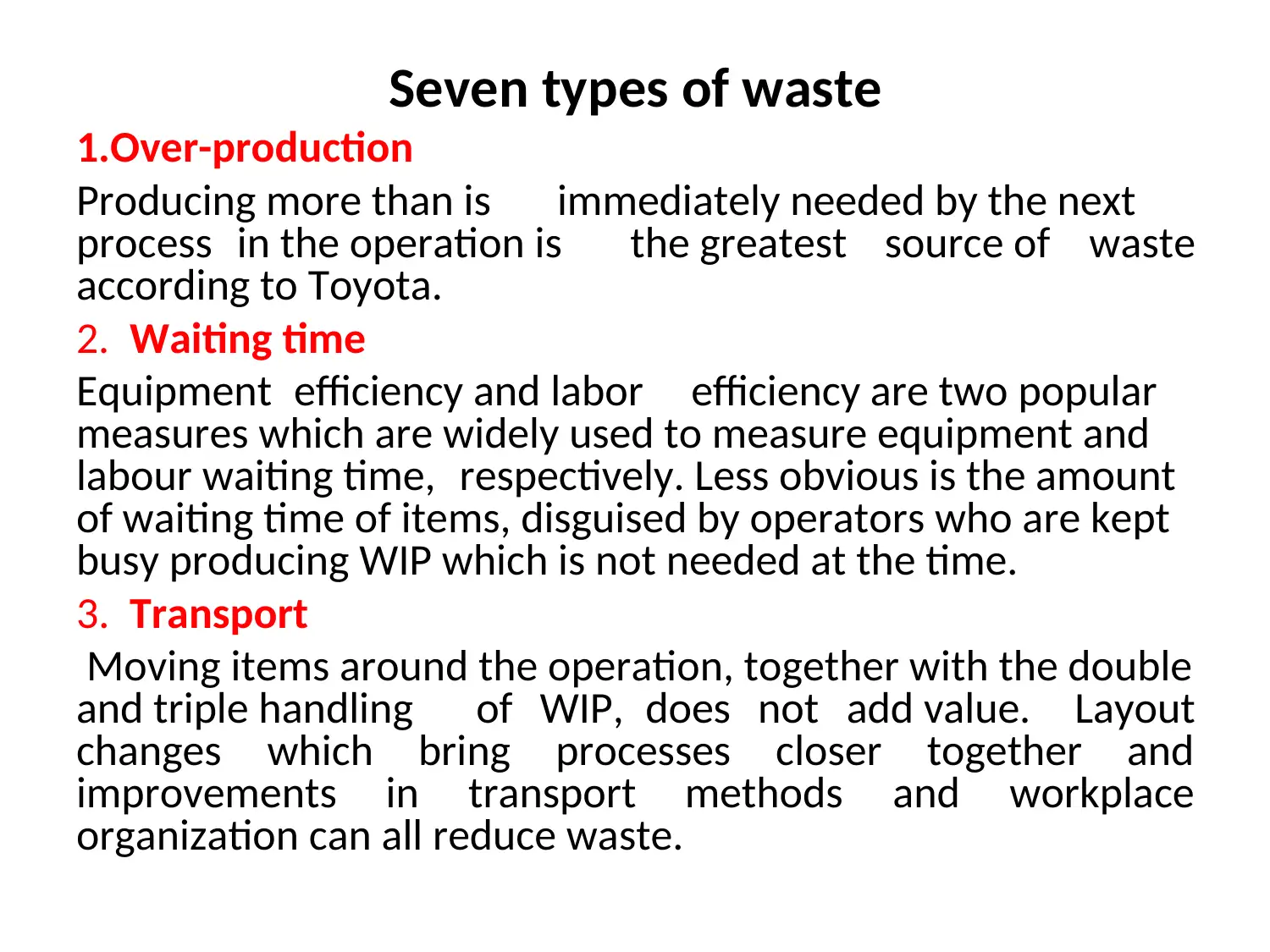
Seven types of waste
1.Over-production
Producing more than is immediately needed by the next
process in the operation is the greatest source of waste
according to Toyota.
2. Waiting time
Equipment efficiency and labor efficiency are two popular
measures which are widely used to measure equipment and
labour waiting time, respectively. Less obvious is the amount
of waiting time of items, disguised by operators who are kept
busy producing WIP which is not needed at the time.
3. Transport
Moving items around the operation, together with the double
and triple handling of WIP, does not add value. Layout
changes which bring processes closer together and
improvements in transport methods and workplace
organization can all reduce waste.
1.Over-production
Producing more than is immediately needed by the next
process in the operation is the greatest source of waste
according to Toyota.
2. Waiting time
Equipment efficiency and labor efficiency are two popular
measures which are widely used to measure equipment and
labour waiting time, respectively. Less obvious is the amount
of waiting time of items, disguised by operators who are kept
busy producing WIP which is not needed at the time.
3. Transport
Moving items around the operation, together with the double
and triple handling of WIP, does not add value. Layout
changes which bring processes closer together and
improvements in transport methods and workplace
organization can all reduce waste.
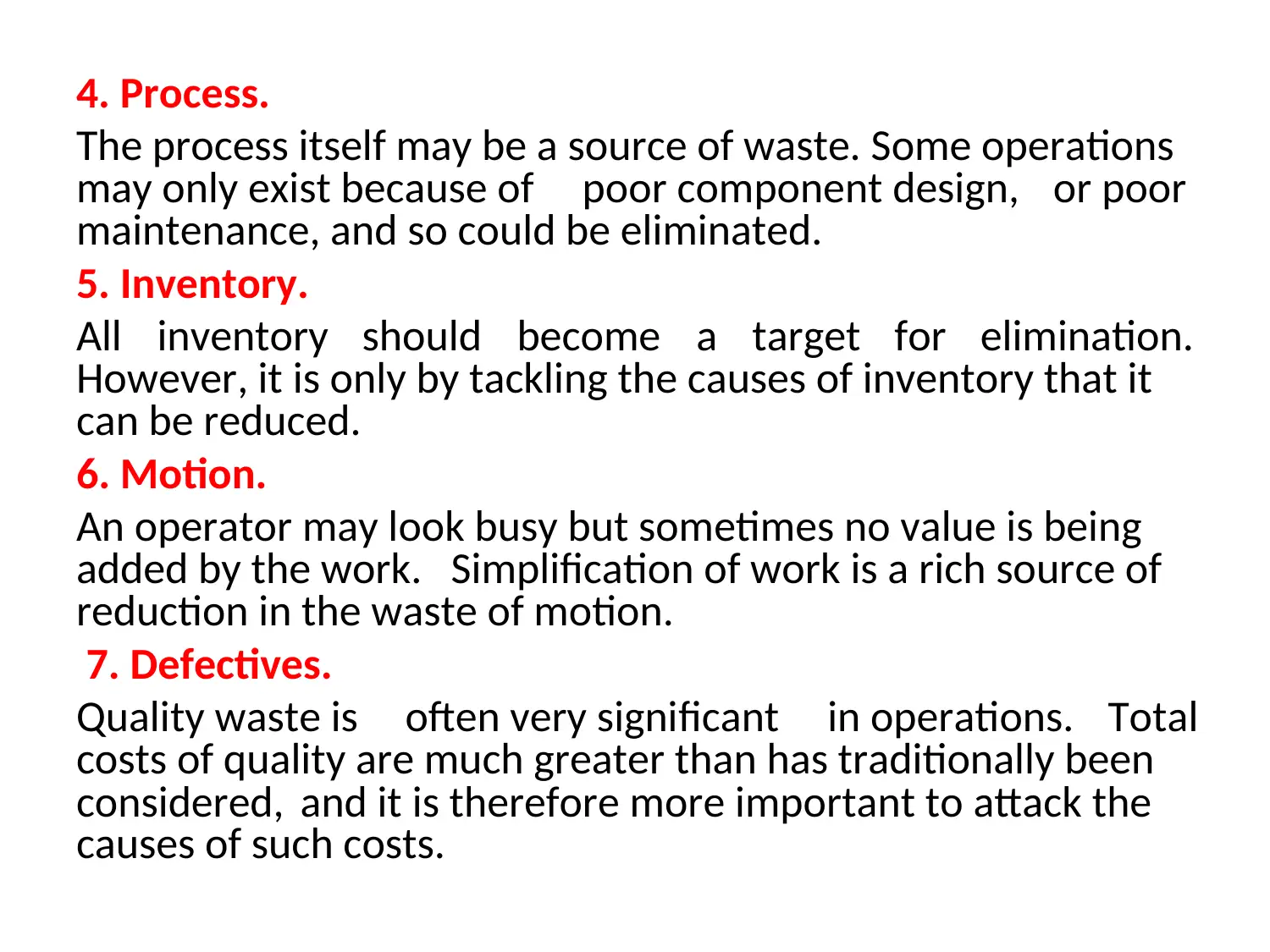
4. Process.
The process itself may be a source of waste. Some operations
may only exist because of poor component design, or poor
maintenance, and so could be eliminated.
5. Inventory.
All inventory should become a target for elimination.
However, it is only by tackling the causes of inventory that it
can be reduced.
6. Motion.
An operator may look busy but sometimes no value is being
added by the work. Simplification of work is a rich source of
reduction in the waste of motion.
7. Defectives.
Quality waste is often very significant in operations. Total
costs of quality are much greater than has traditionally been
considered, and it is therefore more important to attack the
causes of such costs.
The process itself may be a source of waste. Some operations
may only exist because of poor component design, or poor
maintenance, and so could be eliminated.
5. Inventory.
All inventory should become a target for elimination.
However, it is only by tackling the causes of inventory that it
can be reduced.
6. Motion.
An operator may look busy but sometimes no value is being
added by the work. Simplification of work is a rich source of
reduction in the waste of motion.
7. Defectives.
Quality waste is often very significant in operations. Total
costs of quality are much greater than has traditionally been
considered, and it is therefore more important to attack the
causes of such costs.
⊘ This is a preview!⊘
Do you want full access?
Subscribe today to unlock all pages.

Trusted by 1+ million students worldwide
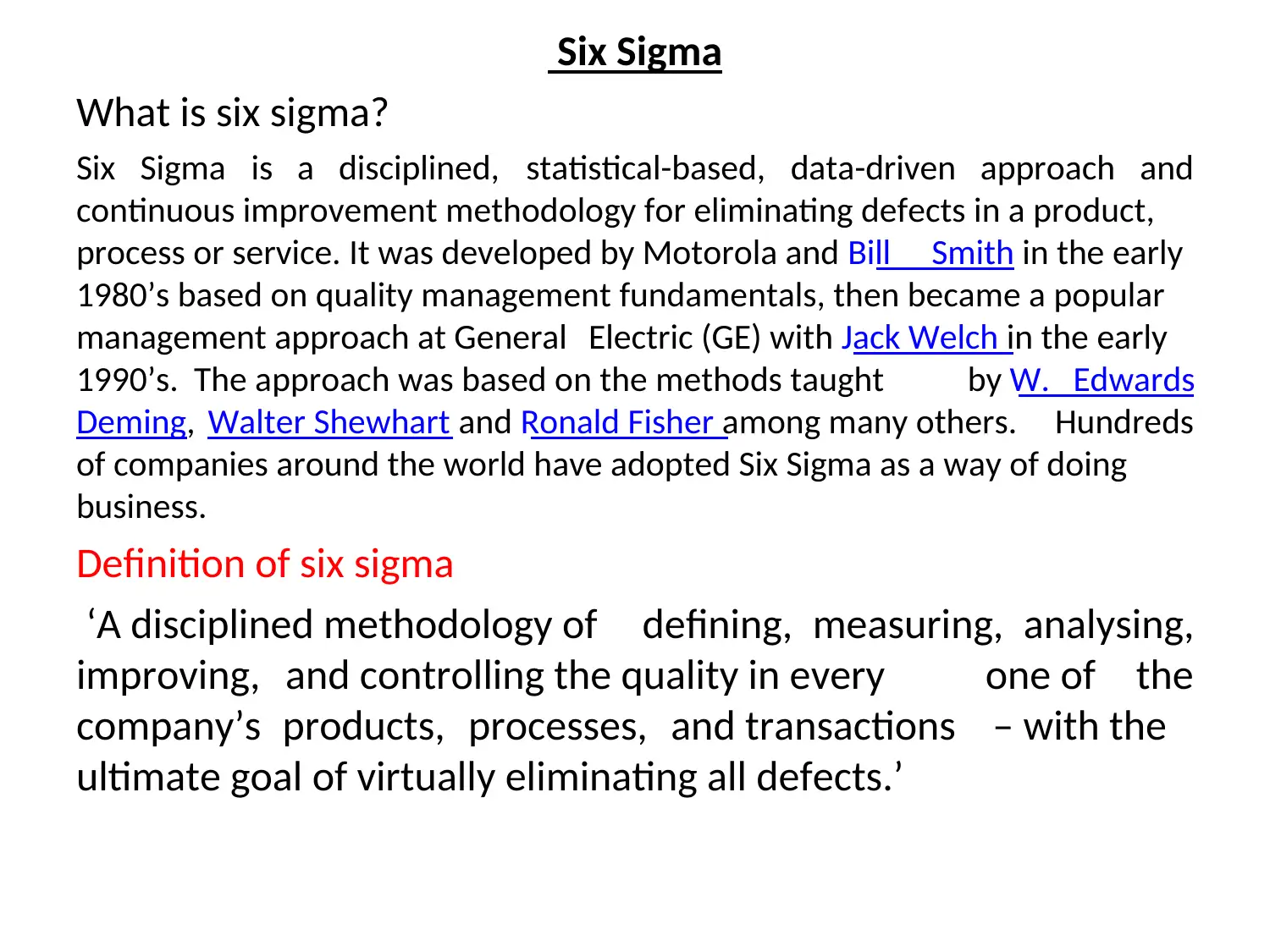
Six Sigma
What is six sigma?
Six Sigma is a disciplined, statistical-based, data-driven approach and
continuous improvement methodology for eliminating defects in a product,
process or service. It was developed by Motorola and Bill Smith in the early
1980’s based on quality management fundamentals, then became a popular
management approach at General Electric (GE) with Jack Welch in the early
1990’s. The approach was based on the methods taught by W. Edwards
Deming, Walter Shewhart and Ronald Fisher among many others. Hundreds
of companies around the world have adopted Six Sigma as a way of doing
business.
Definition of six sigma
‘A disciplined methodology of defining, measuring, analysing,
improving, and controlling the quality in every one of the
company’s products, processes, and transactions – with the
ultimate goal of virtually eliminating all defects.’
What is six sigma?
Six Sigma is a disciplined, statistical-based, data-driven approach and
continuous improvement methodology for eliminating defects in a product,
process or service. It was developed by Motorola and Bill Smith in the early
1980’s based on quality management fundamentals, then became a popular
management approach at General Electric (GE) with Jack Welch in the early
1990’s. The approach was based on the methods taught by W. Edwards
Deming, Walter Shewhart and Ronald Fisher among many others. Hundreds
of companies around the world have adopted Six Sigma as a way of doing
business.
Definition of six sigma
‘A disciplined methodology of defining, measuring, analysing,
improving, and controlling the quality in every one of the
company’s products, processes, and transactions – with the
ultimate goal of virtually eliminating all defects.’
Paraphrase This Document
Need a fresh take? Get an instant paraphrase of this document with our AI Paraphraser
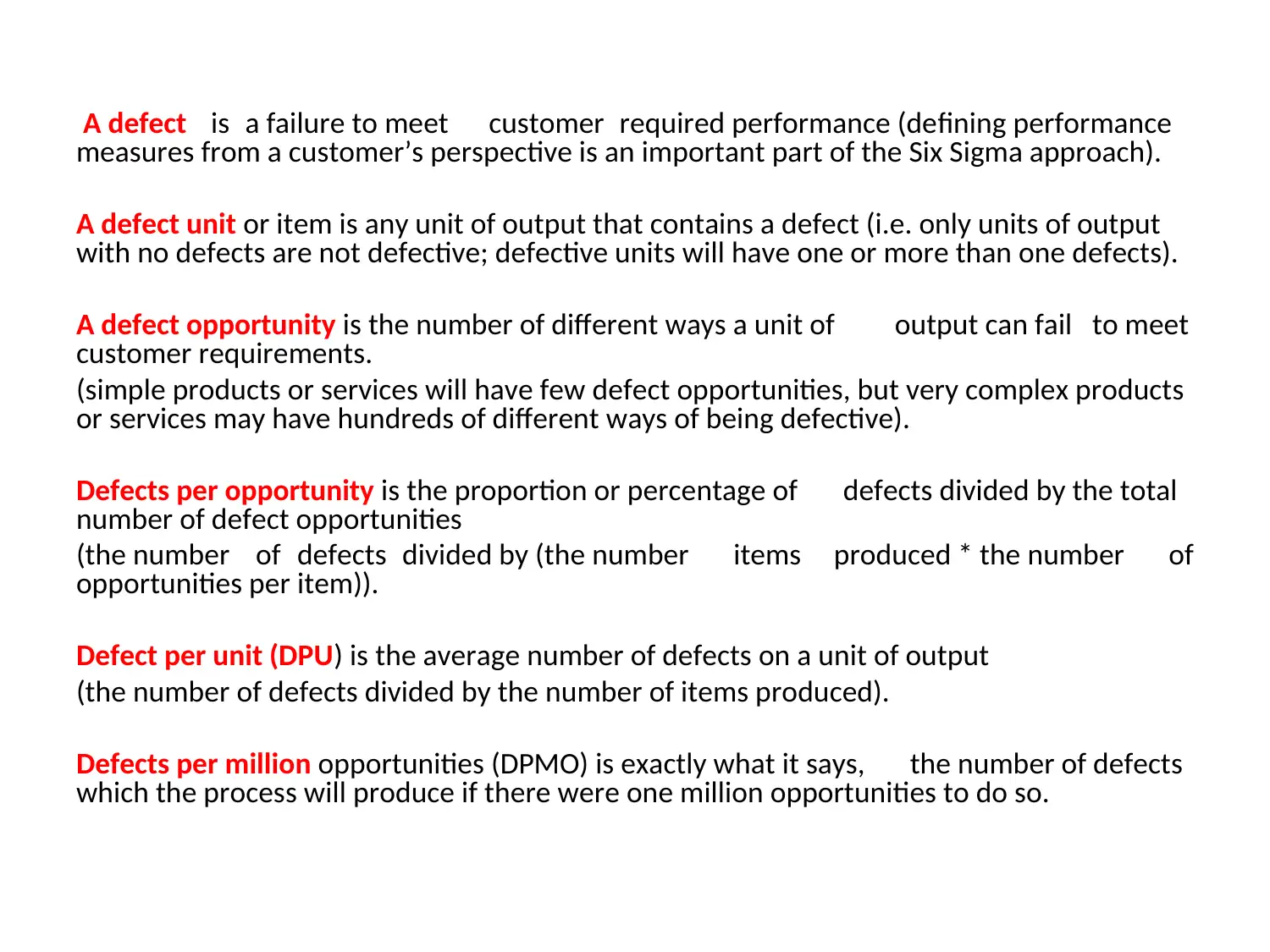
A defect is a failure to meet customer required performance (defining performance
measures from a customer’s perspective is an important part of the Six Sigma approach).
A defect unit or item is any unit of output that contains a defect (i.e. only units of output
with no defects are not defective; defective units will have one or more than one defects).
A defect opportunity is the number of different ways a unit of output can fail to meet
customer requirements.
(simple products or services will have few defect opportunities, but very complex products
or services may have hundreds of different ways of being defective).
Defects per opportunity is the proportion or percentage of defects divided by the total
number of defect opportunities
(the number of defects divided by (the number items produced * the number of
opportunities per item)).
Defect per unit (DPU) is the average number of defects on a unit of output
(the number of defects divided by the number of items produced).
Defects per million opportunities (DPMO) is exactly what it says, the number of defects
which the process will produce if there were one million opportunities to do so.
measures from a customer’s perspective is an important part of the Six Sigma approach).
A defect unit or item is any unit of output that contains a defect (i.e. only units of output
with no defects are not defective; defective units will have one or more than one defects).
A defect opportunity is the number of different ways a unit of output can fail to meet
customer requirements.
(simple products or services will have few defect opportunities, but very complex products
or services may have hundreds of different ways of being defective).
Defects per opportunity is the proportion or percentage of defects divided by the total
number of defect opportunities
(the number of defects divided by (the number items produced * the number of
opportunities per item)).
Defect per unit (DPU) is the average number of defects on a unit of output
(the number of defects divided by the number of items produced).
Defects per million opportunities (DPMO) is exactly what it says, the number of defects
which the process will produce if there were one million opportunities to do so.
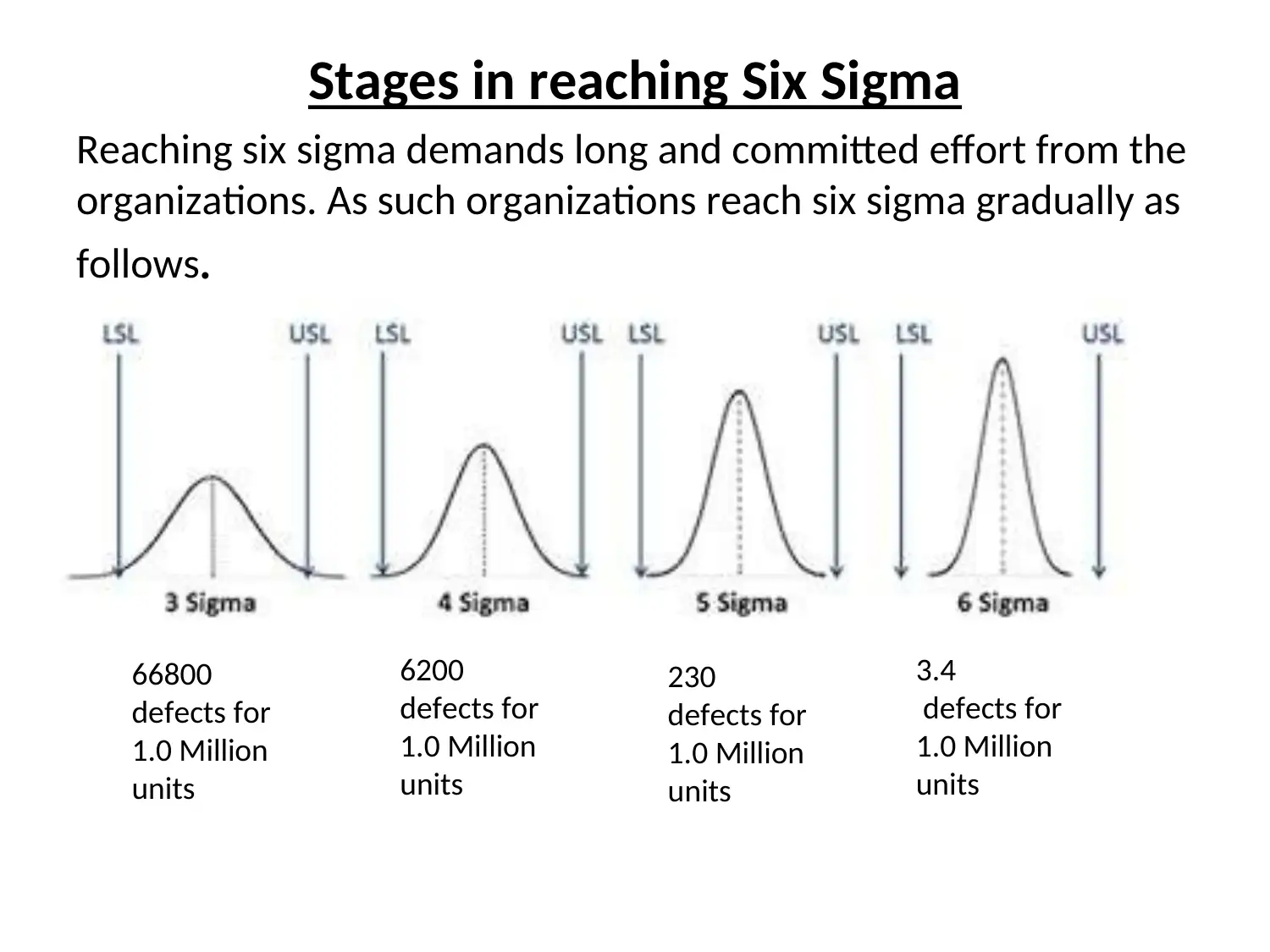
Stages in reaching Six Sigma
Reaching six sigma demands long and committed effort from the
organizations. As such organizations reach six sigma gradually as
follows.
66800
defects for
1.0 Million
units
230
defects for
1.0 Million
units
3.4
defects for
1.0 Million
units
6200
defects for
1.0 Million
units
Reaching six sigma demands long and committed effort from the
organizations. As such organizations reach six sigma gradually as
follows.
66800
defects for
1.0 Million
units
230
defects for
1.0 Million
units
3.4
defects for
1.0 Million
units
6200
defects for
1.0 Million
units
⊘ This is a preview!⊘
Do you want full access?
Subscribe today to unlock all pages.

Trusted by 1+ million students worldwide
1 out of 16
Related Documents
Your All-in-One AI-Powered Toolkit for Academic Success.
+13062052269
info@desklib.com
Available 24*7 on WhatsApp / Email
![[object Object]](/_next/static/media/star-bottom.7253800d.svg)
Unlock your academic potential
Copyright © 2020–2025 A2Z Services. All Rights Reserved. Developed and managed by ZUCOL.



